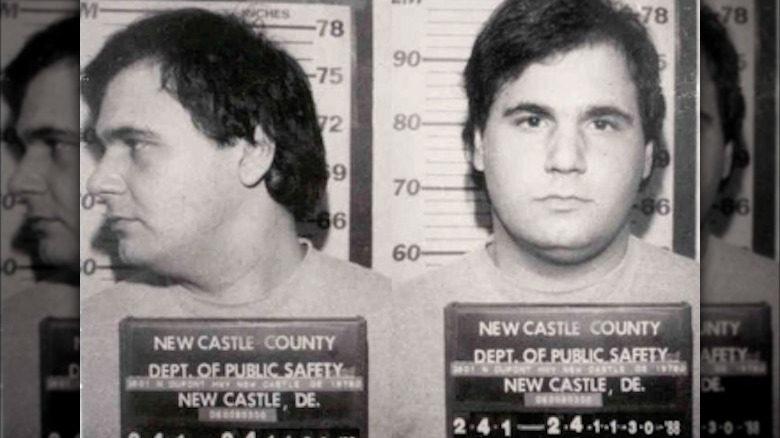How Delaware's Only Known Serial Killer Was Finally Caught
It can be said that the world's oldest profession is also one of the most dangerous (per The Conversation). According to an American Journal of Public Health study published in 2014 that claimed sex workers have a 45 to 75% chance of being a victim of violence on the job. Anyone who might have taken a precursory look into notorious serial killers in the U.S. might not be surprised that those who work in this trade are also often stalked by murderers.
But why are sex workers such a large target for serial predators? Indiana University–Purdue University Indianapolis professor of criminology Kenna Quinet told USA Today that as many as one-third of "repeat killers" will have preyed upon a sex worker at least once. She cautions that this statistic might be even higher, claiming that the "missing missing" (a term she coined to refer to missing persons that are never reported missing) could certainly skew the number of sex workers who are murdered upward. The publication points out that those in this industry are at a greater risk for violence and are often seen as targets by serial killers. A sex worker is easily accessible, making quick contact with them possible. Their disappearances are also less likely to be immediately noticed.
Perhaps this is why Steven Brian Pennell chose to stalk and kill his victims, all of whom were known to be sex workers. Working the Route 40 corridor in 1987 and 1988, Pennell would pick up his victims and brutally murder them, disposing of their bodies along the route (via Murderpedia).
Pennell killed his first victim in 1987
When police began to suspect that there was a serial killer on the loose in Delaware, they went into action and initiated a decoy operation using officer Renee Taschner (via Oxygen). The 23-year-old cop "worked" as a sex worker along Route 40 in hopes that she could make contact with the person responsible for the recent murders in the area (per Delaware Today). Her bravery and guile resulted in a prime suspect in the killings, as well as an eventual arrest and conviction.
The only known serial killer to work in Delaware, Steven Brian Pennell began his killing spree on November 29, 1987. His first victim was 23-year-old Shirley Ellis, a former sex worker who was, according to her family, out of the business and now studying to become a nurse (via Oxygen). Ellis had been visiting a friend at a local hospital on that fateful evening before heading home. Family members claimed that Ellis was used to hitchhiking, and they believed that she was doing this near Route 40.
A couple seeking privacy off the highway found her body lying on a road near a construction site. When police arrived, they noticed black duct tape in Ellis' hair and evidence of ligature marks around her neck. Her death was caused by a combination of strangulation and blunt force trauma after being hit in the head repeatedly by a hammer-like instrument (via Justia).
The police begin a decoy operation
Seven months later, workers at a different construction site off Route 40 found the body of 31-year-old Catherine DiMauro (via Justia). Her nude body was discovered early in the morning of June 29, 1988. A known sex worker, DiMauro's body was left in a condition that was chillingly similar to Ellis'. Duct tape was found in her hair, and she was killed in the same fashion. Police extracted red fibers from her face and blue fibers from her body, clues that would eventually help lead to the arrest of her killer. Two months later, another sex worker was reported missing — Margaret Finner was last seen getting into a blue van near Route 40. Witnesses say the driver was a white male. After getting into the vehicle on August 22, she was never seen again.
Renee Taschner and other undercover officers had begun working an operation along Route 40 shortly after the discovery of DiMauro's body. She and the other female officers involved dressed like sex workers and were instructed to engage in conversations with any men who might stop. On September 14, Taschner took note of a blue van that drove by her seven times and radioed in the license plates. It belonged to Steven Brian Pennell.
A torture kit was found after executing a search warrant
After moving to a place on Route 40 that wasn't as brightly lit, the blue van stopped, its driver encouraging Renee Taschner to climb aboard. Pretending to have a headache, the undercover cop successfully refused. She did note that the inside of the van was covered in blue carpeting, and she even managed to swipe some samples of it before she walked away. Days later, on September 20, the body of Michelle Gordon was discovered in a canal (via Justia). Though her body had similar injuries as the ones found on Catherine DiMauro and Shirley Ellis, a cause of death couldn't be determined as she was found submerged in the water. The medical examiner did, however, state that it was a homicide.
With the blue fibers being analyzed, the police began surveillance on Steven Brian Pennell. He was observed frequently driving back and forth on the same stretch of Route 40 that Taschner had met him on. On September 30, 1988, police pulled Pennell over for a traffic offense. The officer noticed what appeared to be a blood stain on the van's blue carpeting. A search warrant was issued, resulting in Pennell's van, storage shed, and home being searched. Investigators found rolls of duct tape and a buck knife. But according to Delaware Today, their attention was captured by the discovery of what would later be referred to as a "torture kit," containing "pliers, a whip, handcuffs, needles, knives and restraints." Hair and blood from his victims were also recovered from his van.
Pennell argued for himself to receive the death penalty
Steven Brian Pennell was charged with three counts of first-degree murder in the deaths of Catherine DiMauro, Shirley Ellis, and Michelle Gordon (per Justia). One of the key pieces of evidence was the blue fibers from his van that matched the fibers found on DiMauro's body. Ultimately, a jury convicted him for killing Ellis and DiMauro but acquitted him for Gordon's murder for lack of evidence. He was sentenced to two life terms.
But his conviction doesn't end here. After his attorney filed for an appeal, Delaware Today reports that prosecutors charged Pennell with two counts of first-degree murder in the deaths of Gordon (citing new evidence) and a fourth woman, Kathleen Meyer. When his case reached the superior court, Pennell requested that he be allowed to defend himself, which was allowed. He shocked the courtroom when he asked to receive the death penalty. His request was granted.
In Delaware, the law sends all death sentences to be reviewed by the state Supreme Court. Pennell argued for the death penalty in front of this five-person court, which granted his wishes. He was executed on March 14, 1992.




